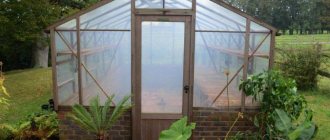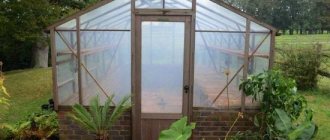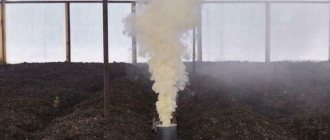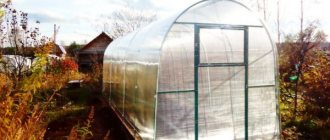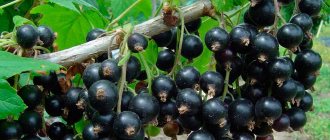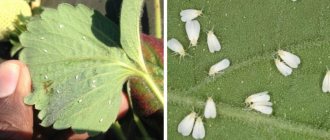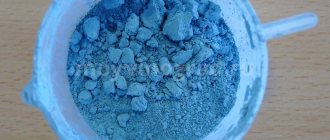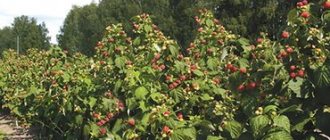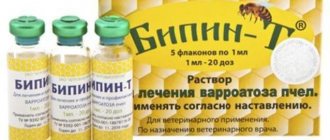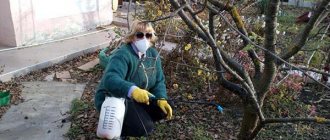After harvesting vegetables, it is necessary to include sanitary treatment of the polycarbonate greenhouse in the autumn in the schedule of activities. During the last rotation, harmful bacteria, viruses, harmful insects and fungi, which can safely overwinter under a layer of snow and plant debris, could accumulate and multiply in the cultivation room. With the onset of spring, they will come out of their hiding places and begin to attack cultivated plants.
In order to prevent the mass reproduction of pests and pathogenic microorganisms, in the autumn a set of measures is carried out to clean and disinfect protected ground structures. Based on the advice and recommendations of experienced gardeners, we have put together all the information on how such work should be carried out.
When to treat a greenhouse in the fall
The process of preparing a greenhouse structure for the next season is quite labor-intensive and it is better to carry it out in stages. If, due to lack of time or for other reasons, you postpone these activities until spring, it will be wrong. Various parts of the supporting frame and plant debris left on the soil may contain larvae of parasitic insects and pathogens of such dangerous diseases as:
- scab;
- olive spot;
- late blight;
- peronosporosis;
- powdery mildew;
- anthracnose
If you ignore the treatment of the greenhouse in the fall, all these pathogens will attack the tomato or cucumber seedlings in the spring, causing big problems for the owners of the plots.
It is especially important to carry out treatment against pests and diseases in the fall if you do not plan to replace the soil in the greenhouse.
In this regard, it becomes clear when it is better to treat the greenhouse - in autumn or spring. To better preserve the future harvest and reduce the risk of plants being damaged by dangerous diseases, this work should be done in the fall, after the next harvest.
How to treat a greenhouse in the fall after harvesting? Preventive work is carried out according to the following algorithm:
- collection and removal of plant residues from the greenhouse;
- cleaning and washing the roof and walls;
- soil treatment and preparation activities;
- disinfection of cultivation premises;
- minor repairs to the greenhouse.
When planning work, it is not necessary to adhere to any exact deadlines or dates according to the Lunar calendar. They depend on the crop that was last grown in the greenhouse and the prevailing weather conditions. But there is little point in postponing sanitary treatment until later if the greenhouse is empty and nothing is grown there anymore.
To carry out autumn preventive work in the greenhouse, you need to choose a fine day, when the air temperature varies within 10-15 degrees above zero.
Features when cleaning: what to pay attention to
- When cleaning the greenhouse in the fall, you need to pay attention to the tops. If it is affected by larvae and other pests, then it is better to burn it. If the plants are healthy, they can be placed on the compost heap.
- When removing supports and twine residues, they may also harbor bacteria. Therefore, they should be burned or placed in a trash bin. If reusable metal supports are used in the greenhouse, they are processed together with other frame elements.
- Close attention should be paid to the gap between the frames, as well as to places under stale stones and other hard and flat materials. As a rule, many pests accumulate under them: mole cricket larvae, all kinds of worms and wireworm embryos. They must be collected manually in the fall, since they are not afraid of frost under such protection, and they can be preserved.
- If the greenhouse is covered with film, it is recommended to remove it before the onset of winter, when the temperature is still above zero. This coating also needs to be cleaned of dirt, allowed to dry, folded and stored in a dry place with a positive temperature (for example, in a basement).
- 5. The metal structure also needs to be put in order. First, carefully inspect from all sides. If traces of corrosion are found, they must be thoroughly cleaned with fine sandpaper. Then coat it with a primer, which will prevent the spread of rust, and paint it with a paint of a suitable color.
Attention!
It is safer to burn crop residues (roots, tops, mulch) and other debris rather than leaving them in an empty place or burying them in the ground.
What pathogenic organisms overwinter in a greenhouse?
When planning autumn events, it is important to understand exactly what pests and pathogens of dangerous diseases remain in the greenhouse for the winter and what conditions they need for this.
Aphid
These insects drink the juice of cultivated plants. In the greenhouse they multiply quickly, parasitizing young shoots. During their life, insects secrete a sweet, sticky liquid on which harmful fungi develop.
During the winter, aphids lay eggs on plant debris. With the onset of positive spring temperatures, the eggs hatch into larvae, which then turn into adults. Aphids can be hidden in their nests by ants, who feed on its sweet secretions, using it as a milk cow.
When planning measures to combat aphids, it is necessary to simultaneously expel ants from the greenhouse.
Whitefly
It has a size comparable to an aphid, but can fly. White insects settle in large numbers on young plants and drink their juice. When overwintering in a greenhouse, the insect can withstand temperatures down to minus 5 degrees.
- In regions with frosty winters, you can destroy wintering individuals by freezing, creating a temperature in the greenhouse below 5 degrees below zero.
- In southern areas you will have to use a chemical agent.
Spider mite
The insect is small in size, but capable of destroying plants in a short period of time. It feeds on plant sap, leaving small dots on the underside of the leaf. It leaves a thin web where the leaves are attached.
The adult insect overwinters in various crevices or in debris. Folk remedies and acaricides are used against ticks.
Slugs
They have a gnawing type mouthparts. During the day, slugs sit in secluded places, and at night they go out hunting, gnawing on young shoots, leaves and fruits.
Slug larvae remain in the soil layer and can be destroyed with hot water or chemicals.
Nematode
The pest belongs to the class of roundworms. Small, barely noticeable worms parasitize the roots and stems of vegetable plants, causing great damage to the crop.
It's difficult to fight her. For wintering, roundworms are located in the thickness of the earth, at a depth of 20 cm, or remain in galls - thickenings on the root system.
Fungal infection
These include:
- late blight,
- cladosporiosis,
- fusarium,
- powdery mildew,
- numerous types of rot.
The disease occurs under poor growing conditions and quickly spreads on plants, taking away a significant part of the crop. It is not easy to fight it, since the fungi have become resistant to chemicals.
They spend the winter in the greenhouse on equipment, on the soil and walls of the room. Drugs that belong to the group of fungicides are effective in the fight.
Viral and bacterial infection
They are brought into the greenhouse with seeds, soil and insects. Therefore, preventive measures in this case include:
- cleaning of plant fragments;
- application of insecticides;
- use of drugs against bacteria.
How to strengthen a polycarbonate greenhouse for the winter
The design of any greenhouse structure from which the covering is not removed is subject to significant gusts of wind and snow loads. And if the frame is not strengthened, then it is likely that partial or complete destruction of the structure will occur. To prevent this from happening, there are several effective techniques, both one-time and permanent:
Technique No. 1. Additional arcs. One method is to strengthen the existing frame using duplicate profiles. To do this, use a pipe bender, using heat, or in some other way to bend a square pipe, preferably the same cross-section, with a radius slightly smaller than the existing one. Substituting the newly manufactured parts from below under the mounted arcs, they need to be welded.
Technique No. 2. The second similar way to strengthen the frame of a greenhouse will be to make exactly the same arches and place them not at the bottom, but next to the existing profiles, only with a more frequent step. If you strengthen the structure in this way, then it will not be afraid of any loads, since the frame can withstand from 170 kg/m2 to 250 kg/m2.
Attention! After welding, all seams must be cleaned with a grinder and covered with a primer, followed by painting.
Technique No. 3. Replacement of roofing. If a budget gable greenhouse is covered with 4 mm polycarbonate, then it would be quite justified to replace these sheets on top with 8 mm sheets and on the sides with 6 mm sheets made of this material.
Technique No. 4. Supports. The most commonly used method of fixing the structure is the erection of supports in the greenhouse. They can be made from different materials: poles, timber, slabs, etc. The use of longitudinal and transverse supports is also practiced.
The longitudinal elements are installed closely with the ridge profile and supported from below by vertical posts. Lateral reinforcement is a little more difficult to do. This will require more material, but it is also more reliable than the previous one.
The accompanying material is installed at the bottom of the transverse arches in the form of spacers and is attached at the junction with the longitudinal profile pipes. Here you can also temporarily install vertical supports to strengthen the frame.
Insulating a greenhouse for the winter
In the case when the owner of a summer cottage needs to insulate a greenhouse rather than heat it, several methods can be used. They are used both at the beginning of construction and during operation of the greenhouse, there is no significant difference.
In this case, this procedure can be subdivided:
- by expenses;
- by performance;
- by time spent.
Method No. 1. Sealing gaps. In this process, sealing is most important, since the main heat leaks through the grooves, cracks and holes. For greenhouses made of cellular polycarbonate, polyurethane foam and silicone sealant are usually used for these purposes. Taping is allowed, but it is effective if it is a construction material.
Method No. 2. Covering the cut of a cellular polycarbonate panel. In addition to the cracks, when insulating a greenhouse it is also important to close the channels at the cut of the panel. In this case, you can use one of two methods. The first step is to install a polymer profile on the end of the sheet. If this is not possible, then you can use mastic or sealant for these purposes: one of them simply coats the top of the panel. There is no need to seal the bottom end of the sheet, since the condensate formed from the temperature difference should flow through the holes.
These two methods solve the problem if the street temperature does not drop below +3 degrees. If the thermometer drops below this mark, then drastic measures need to be taken.
Method No. 3. Additional covering of the greenhouse. When insulating with a second layer of polycarbonate, it is important not to damage the bottom covering. Therefore, you cannot drill at the very edge of the sheet, so as not to damage the sheet, and the holes for the screws with washers should be slightly larger than their diameter. This must be observed to stabilize the linear expansion near the holes, thus preventing cracks from forming.
Method No. 4. Warming the soil on ridges. If you need to insulate the ground before planting seedlings, you can use manure mixed with straw or compost. The last mixture is prepared as follows: sawdust mixed with quicklime is poured up to 35 cm (lime is laid at the rate of 350 grams per 1 m2). After it begins to warm up, cover it with a layer of soil and the seedlings can be planted.
Method No. 5. Laying a special insulation under the soil layer. This insulating material is laid through a polymer sheet in two layers with an air gap between them.
Method No. 6. You can also lay foam plastic in the lower part of a frame made to the size of the ridge, and pour a layer of earth on top.
All these methods are appropriate for vegetable growers if the task is to insulate a greenhouse, and which method to choose is up to the owner of the dacha plot to decide.
Should I open the greenhouse for the winter?
Until now, gardeners do not have the same opinion about whether to keep the greenhouse open or closed in winter.
Arguments in favor of open doors:
- Freezing of the ground. When the soil in greenhouse structures freezes, harmful bacteria and insect larvae die, and the soil is cleared of infectious viruses. When the greenhouse doors are open in winter, the temperature is balanced outside and inside the building, and not only harmful larvae die, but also fungal spores and pathogens remaining for the winter.
- Snow on the beds. When the doors are open during snowfall, the ground is covered with a thick layer of snow (30-40 cm). With the onset of warm spring days, this snow cover will melt and serve as a good moisturizer for the earth.
- No stuck snow on the roof of the greenhouse. When the greenhouse structure is closed, the temperature inside is slightly higher than the outside temperature. This leads to the fact that warm air rises upward and causes the melting of the lower layer of snow cover on the roof of the greenhouse. Then, during frost, the melted liquid freezes to the covering and forms a crust on the roof of the greenhouse and does not allow the snow to “roll off” or remove the snow “cap”. Gradually, this leads to the formation of a heavy substance on the roof, which during a thaw creates an excessive load on the frame and can push through it.
This phenomenon can be avoided by balancing the temperature inside and outside by opening the doors.
- Condensate. When the greenhouse is closed in the fall in October and November at subzero temperatures, the temperature inside the room is noticeably higher than outside. The soil continues to “breathe” and condensation forms on the surface of the ceiling, which then falls down to the ground in the form of a drop. Thus, the humidity in the greenhouse increases, and, consequently, fungus and mold form on the soil and structure.
Also, one of the methods to avoid this unpleasant situation is to ventilate the greenhouse space by opening the doors.
Arguments in favor of closed doors:
- In winter, during snow storms and strong gusts of wind, the frame of the greenhouse can become loose, and if the wind blows inside the structure, there is a possibility of the entire structure collapsing.
- Too much snow may get into the greenhouse, which will cause delayed soil warming.
As can be seen from the above arguments, most of the arguments speak in favor of open doors in the greenhouse. Of course, the owner of the dacha or garden will have to decide, but it should still be noted that the main purpose of the greenhouse is to obtain a harvest of early pimply cucumbers. And if this does not happen, then all arguments will be blurred and reduced to zero.
Treatment methods for diseases and pests
All microflora inhabiting the soil are divided into harmful and beneficial. It is important to select drugs that selectively kill only organisms harmful to plants.
Effective methods for treating a polycarbonate greenhouse in the fall
Purchased preparations for treating greenhouses
The list of purchased chemicals is quite large and the bulk of them belong to broad-spectrum products.
However, it is recommended to purchase narrowly targeted preparations so that the beneficial soil microflora does not suffer.
How to treat a polycarbonate greenhouse in the fall? The most widely used drugs are:
Fufanon
The product is effectively used in the fight against aphids, thrips, whiteflies and spider mites.
To prepare the working solution, dissolve 10 ml of the drug in 10 liters of water and, using a sprayer, apply the insecticide solution to the expected wintering sites of pests:
- garden bed fencing elements;
- gaps in frame joints;
- soil surface.
Storm
This product is widely used to kill slugs and snails. To use it, you do not need to dissolve it in water, but simply scatter it after harvesting the previous crop onto the soil surface at the rate of 30 g per 10 m2.
During their movements, slugs will come into contact with the product, after which they will experience complete dehydration of the body, resulting in death. With the onset of cold weather, the effectiveness of the drug drops sharply.
Muratsid
This method is used to kill ants. To prepare the working solution, 1 ampoule of the product is dissolved in a bucket of water. Then a liter of solution is poured into the discovered ant nests.
When trying to leave the nest, the ants die. For greater efficiency, you can spill the solution along the ant paths.
Thunder
Used to kill mole crickets and ants. If there are mole cricket holes, pour 1 tsp near them. product, slightly moisturizing it. The mole cricket will definitely try it and soon die. To get rid of ants, dry powder is poured directly onto the anthill.
Marshal
Used by vegetable growers against aphids, spider mites, root-knot nematodes and thrips. Before use, 1 ampoule of the drug, with a capacity of 7 ml, is dissolved in 10 liters of water and the solution is spilled on the soil.
One bucket is enough to treat 10 m2 of area.
Only 1 treatment is allowed per season. The drug is very poisonous and dangerous for humans and warm-blooded animals.
Fitosporin
The product belongs to a group of biological substances intended for the prevention and treatment of fungal diseases. Before use, 5 g of the product is dissolved in 10 liters of water and the resulting solution is irrigated on the soil surface, ceiling and walls of the greenhouse.
When the temperature drops to +10 degrees, treatment with this drug is stopped, since its beneficial bacteria lose activity.
Copper sulfate
This drug is used for comprehensive disinfection of the greenhouse. To use, dilute 1 tbsp. l. vitriol in a bucket of water. The prepared solution is used to irrigate the soil and walls of the greenhouses abundantly.
When treating greenhouse premises with copper sulfate, you must strictly maintain the dose and follow safety precautions.
Methods for controlling nematodes
The nematode is one of the most dangerous pests of greenhouse crops. Appearing on the roots of cucumbers or tomatoes, it forms peculiar growths - galls, which clog the sap-conducting tissues of the root.
These roundworms can reduce crop yield by 50% or even more.
So how can you disinfect a greenhouse from nematodes without replacing the soil? There are such ways to resist this pest:
- Compliance with cultural circulation. It is important to avoid monoculture in the greenhouse. Those vegetable growers who plant the same plants in the same place year after year are greatly mistaken. Ideally, planting should be planned so that the crop returns to its original place no earlier than after 3 years. This is difficult to achieve in a greenhouse, so other control methods are usually used.
- Replacement of soil. With this method, it is necessary to replace all the soil in the greenhouse to a depth of 25 cm or more. But, since this work is very labor-intensive, there are few people willing to do it.
- Soil treatment with hot water or steam. To do this, you need to heat the water to 60 degrees and pour it into the soil to a depth of 20 cm. If you have a steam generator, then hot steam is used instead of water.
- Adding fertilizers and sugar to the soil. Thanks to this method, saprophytic fungi appear in the soil and begin to multiply intensively, which attract the natural enemies of the nematode.
- Chemicals. In industrial greenhouses, systemic nematicides are used against nematodes. They are highly toxic to humans and warm-blooded animals and, along with nematodes, kill beneficial soil microflora. Summer residents use such drugs rarely and with great caution.
- Plants are nematode antagonists. This biological method can be adopted by any summer resident, since it is not very complicated. In addition to the nematode, it affects wireworms and mole crickets. The essence of the method is to plant the following nematode-inhibiting plants immediately after harvesting vegetables:
- marigold;
- calendula;
- leaf mustard;
- oilseed radish;
- watercress.
Green manure – mustard
Use of biologically active drugs
The method of treating a polycarbonate greenhouse in the fall is an alternative to the use of chemicals. It is good for those people who want to protect themselves as much as possible from the harmful effects of chemicals.
The idea is to create favorable conditions in the soil for the development of beneficial microflora. As a result of the work of beneficial soil microorganisms, the activity of pests and infectious agents is suppressed.
For this purpose, the following biologically active agents are added to the soil:
- "Phoenix";
- “Baikal EM-1”;
- “Fitop-Flora – S”;
- "Shine".
These products are dissolved in water at room temperature and then the solution is poured onto the soil. Considering that in cold weather the microorganisms of the drugs do not show activity, soil treatment is carried out at a temperature of +15 degrees and above.
The optimal time to use bioactive agents is immediately after harvest.
Once in the soil, the bacteria begin to multiply. It has been established that they use pathogenic microflora for nutrition, cleaning the soil without the use of chemicals. It is reasonable to use such preparations in combination with biological fungicides, for example, phytosporin.
Fitosporin should be diluted according to the instructions and sprayed onto the soil, frame and walls of the greenhouse. Beneficial microflora will not be harmed by the drug, so it is used for prevention, without waiting for signs of a particular disease to appear.
Efficacy has been established against diseases such as:
- root and stem rot;
- cladosporiosis;
- powdery mildew;
- late blight;
- peronosporosis.
About the use of the drug Trichoplant
Treatment with chemicals against harmful insects
This method of disinfecting a greenhouse is resorted to if, during the next greenhouse rotation, tomatoes and cucumbers suffered from an invasion of pests, and the measures taken did not give the expected result.
When using this method, one should not forget that insecticides rarely act selectively. They kill many beneficial insects. If you strictly follow the instructions when working with such drugs, the amount of associated harm from such processing will decrease.
How to clean a greenhouse in spring, inside and out
Cleanliness is the key to health. This statement is as true for plants as it is for people. If the greenhouse was washed in the fall, then in the spring there will be much less hassle. All that remains is to update the result: go over all the details of the coating with clean water using a regular rag. You can also use an electric sprayer charged with clean water or a washing system, if available.
Polycarbonate requires tenderness! Washing a greenhouse made of cellular polycarbonate should be done carefully, using microfiber cloths or soft sponges. This will prevent scratches and cracks. The water pressure in the washing station when using it should be minimal.
How to wash a greenhouse in the spring if it has been dirty for the winter? Ordinary soapy water is best suited for these purposes (it is better to use laundry soap or special garden soap). You can add a drug to the water against a particularly annoying disease or pest from last season, if there were any.
First, you can go through the greenhouse inside, then outside, leaving the foam on the surfaces for at least 10 minutes. Just when you've finished washing the outside, it's time to go back inside. In the same sequence, rinse all surfaces clean. When washing inside, you should be careful so that the soap solution does not fall on the ground.
Advice! Before you start wet cleaning, dry clean to remove dust and dirt. Then washing will be faster and easier.
How to wash a greenhouse with a washing station
Complex disinfection of greenhouses
In the case where pests have multiplied in the greenhouse or the cultivation room is heavily infected with a fungal, viral or bacterial infection, there is no time for selectively targeted treatment. It is necessary to use complex preparations with a wide spectrum of action and sacrifice beneficial soil microflora.
Such potent agents include:
- “Bleached lime”;
- “Copper sulfate”;
- “Bordeaux liquid”;
- “Farmayod”;
- "Formalin".
Treatment of polycarbonate greenhouses in the fall with these products is carried out after the removal of plant residues and washing.
Let's learn more about these products and how to dilute them before use.
Copper sulfate
The drug is presented as a blue-blue powder. To prepare the working solution, you need to dissolve 1 tbsp. l. products in 10 liters of water. The resulting solution is poured onto the soil and the walls of the greenhouse structure are sprayed.
To a greater extent, it affects various fungi, and also has a detrimental effect on some bacteria and individual insects.
Farmayod
Essentially, it is an aqueous solution of iodine. To use it, it must be diluted in warm water until a light brown color is obtained. Use the prepared solution to treat the soil and greenhouse structures to remove harmful bacteria.
Instead of Farmayod, you can use potassium permanganate. The result will be similar.
Bleaching powder
Sold in hardware stores in the form of a white powder. It is used in dry form (by spraying onto the soil) against harmful insects and pathogenic bacteria. It has also been established that it gives results in the fight against spider mites. To do this, you need to sprinkle lime not only on the soil, but also on the lower part of the greenhouse walls, after moistening them.
Bordeaux mixture
The preparation consists of equal parts of copper sulfate and slaked lime. Kills fungal and bacterial pathogens and some insects well. The effect is achieved only with proper preparation of the drug.
Preparation is carried out according to the following algorithm:
- take 100 g of copper sulfate and dilute it in 1 liter of hot water;
- The composition is stirred until all the crystals are dissolved, and then the volume is brought to 5 liters with cold water;
- at the same time, in another container, dilute 100 g of unslaked lime in 1 liter of water and wait until it is quenched;
- after this, the volume is also adjusted to 5 l;
- Cool both solutions to 24 degrees and combine them, stirring vigorously;
- when mixing, copper sulfate is poured into the lime solution, resulting in a blue Bordeaux mixture;
On the day of preparation, the resulting product is sprayed onto the greenhouse structures and the soil in it.
Formalin
This is a very potent remedy and is used in exceptional cases when the infection in the greenhouse is very large. The drug kills all living things, including beneficial microflora. Since it is very poisonous, work must be carried out in personal protective equipment and a gas mask.
Treatment is carried out by spraying at the rate of 20 ml of 40% solution per 1 cubic meter of greenhouse. Additionally, you can spray the soil with the preparation for greater effect. After treatment, close the greenhouse for 24 hours and then ventilate.
Freezing out the greenhouse
This is the most environmentally friendly way to combat harmful microflora. To do this, you need to leave the windows and doors of the greenhouse open for the winter.
The freezing method is used to get rid of whiteflies and a number of other pests that remain for the winter.
Sulfur treatment
According to many gardeners, treating a polycarbonate greenhouse with gray in the fall is one of the most effective ways to disinfect greenhouses. The gas released when sulfur burns - sulfuric anhydride - kills all living organisms in a confined space.
The gas will penetrate into all hard-to-reach cracks and even into the soil to a depth of 10 cm, destroying harmful insects and rodents hiding there.
For greater efficiency, sulfur is used together with potassium permanganate according to the following algorithm:
- Fires are lit along the central path along the entire length of the greenhouse, every 6-8 meters.
- Then metal baking sheets with a mixture of sulfur and potassium permanganate are laid out on burning coals. The amount of ingredients is calculated so that per 100 m2 of area there are 2 kg of sulfur and 40 g of potassium permanganate.
- For safety reasons, given the very high toxicity of sulfuric anhydride, the placement of baking sheets with sulfur is carried out from the farthest end of the greenhouse towards the exit from it.
- Under the influence of high temperature, sulfur ignites with abundant release of smoke and sulfuric anhydride. After making sure that the sulfur on all baking sheets has ignited, the doors of the cultivation room are tightly closed and exposed to at least 24 hours.
- At the end of the exposure, the greenhouse will need to be thoroughly ventilated for several days. To do this, open all the doors and windows, creating drafts.
Sulfuric anhydride is very harmful to the human body. Therefore, disinfection work must be carried out in personal protective equipment, and a gas mask or respirator with a gas cartridge should be worn on the face.
Video: features of greenhouse sulfur treatment
Visual videos about the rules and mistakes of using sulfur to treat a greenhouse from the channel “Garden with your own hands.”
Video lesson on greenhouse processing from Yulia Minyaeva
Processing a polycarbonate greenhouse in the fall from the author of the channel “Whether in the garden or in the vegetable garden,” as well as preparing the greenhouse for winter.
Replacing or disinfecting soil
During cleaning in the greenhouse, the soil is replaced and disinfected. This is a labor-intensive operation that requires the greatest effort. Because of this, many gardeners ignore such an important point in preparing a greenhouse in the fall, but in vain... Renewed soil directly affects the quality and quantity of the future harvest.
Therefore, it is recommended to change the soil every year, and specifically in the fall, since there is more free time at this time. First, you need to treat the top layer of soil in the greenhouse with chemicals, thereby removing harmful bacteria and toxic microelements remaining in the ground. Then use a shovel to remove the layer of soil and transfer it to a free area of the site, or pour it under fruit trees.
Further, there are two options for replacing the land:
Option No. 1. You can purchase new soil in a special store, and this will be the optimal solution for a vegetable grower. True, purchasing it can cause difficulties, since it is not sold in such large quantities everywhere.
Option No. 2. Prepare the soil yourself. But first you need to find out the chemical composition of the soil, its acidity, and then decide which constituent elements to select for the future soil. The ratios of the components introduced may vary, depending on what will be grown in the greenhouse structure, but usually peat, humus, sand and ash are mixed. You should also purchase fertilizers in sufficient quantities and mix them properly with the soil.
Attention! Although the option of purchasing land in a store seems to be the fastest, when purchasing you can stumble upon unscrupulous sellers and end up with land that was already used in the previous season.
Before updating the ridges, the greenhouse must be disinfected with the necessary means and fumigated with sulfur. When digging up the soil, fertilizers and copper sulfate are added to it to prevent the growth of fungus and mold.
Features of greenhouse processing after tomatoes and cucumbers
Cleaning and disinfecting the greenhouse after harvesting tomatoes and cucumbers has some features that should be highlighted.
How to clean a greenhouse after tomatoes
If during the last season the tomatoes were not subjected to massive pest attacks and did not suffer from fungal diseases, you need to work according to a general plan, which includes the following work:
- collection and removal of plant fragments from the greenhouse;
- restoration of soil fertility;
- cleaning of greenhouse structures.
Below we will tell you how to treat a greenhouse in the fall after harvesting tomatoes.
Tops disposal
It is very important to collect all plant debris (tops, fruits, weeds) and in any case, regardless of the presence of symptoms of damage, burn it. Some pests and pathogens remain overwintering on the stems and leaves of plants, so they can be easily destroyed by burning.
Before burning, the tops are dried in the sun outside the greenhouse. Do not throw away the resulting ashes; they will be useful for fertilizing the soil.
The top layer of soil is dug up with a pitchfork and all the rhizomes are combed out of it, which are then also set on fire.
Improving soil fertility
Tomatoes remove a lot of nutrients from the soil during harvest, which must be restored. To do this, organic fertilizers or green manures are incorporated into the soil. As organic matter, you can add a mixture of:
- compost;
- fresh manure;
- peat;
- humus.
This organic mass is added in quantities of 5 to 12 kg per 1 m2, taking into account the degree of depletion of the soil.
After incorporating green manure or organic matter into the soil, the soil is watered with biological products:
- "Shine";
- "East";
- "Baikal".
Before use, prepare a working solution of these drugs by diluting 150 ml of the product in a bucket of water. Then the soil is irrigated with this solution at the rate of 4 liters per m2.
Cleaning and processing of the structure
The frame of the greenhouse, its walls and roof are washed with a strong soap solution, without using hard brushes and sponges, so as not to scratch the polycarbonate coating.
If the frame of the greenhouse is made of metal, then it should be wiped dry after washing. And the wooden frame is whitened with lime.
Disinfection after diseases and pests
If pests or diseases were noticed in the greenhouse during the last rotation, it is necessary to disinfect it. When choosing disinfectants for treating a polycarbonate greenhouse in the fall, take into account the material from which the frame is made.
- Metal carcass. Such material is disinfected with boiling water or 9% vinegar diluted with 20 parts of water.
- Frame made of PVC pipes. Treat with a solution of bleach (400 g of product per bucket of water). For processing, take the upper clarified layer of liquid. A vinegar solution used on a metal frame is also suitable for disinfecting such frames.
- Wooden frame. Wooden structures are treated with copper sulfate or Bordeaux mixture. The concentration of funds should be from 7 to 10%.
Sulfur fumigation is suitable for disinfecting any type of frame, which we described in detail in other sections of this article.
Before fumigating with sulfur, lubricate the metal frame and parts with grease. It will protect the metal from damage.
The polycarbonate covering of the greenhouse after tomatoes is disinfected with a solution of bleach or a strong solution of potassium permanganate.
Soil disinfection
This treatment with chemicals is carried out only in the fall, since when applied in the spring, toxic substances can accumulate in the fruits. If diseases have been noticed on tomatoes during their growth, then you need to spray the soil with one of the following preparations:
- 10% solution of copper sulfate;
- 10% solution of Bordeaux mixture;
- 2.5% solution of iron sulfate;
- “Fitosporin – M” (at temperatures above +10 degrees)
- “Trichodermin”;
- “Fitoverm”;
- “Gaupsin”;
- 10% bleach solution (if spider mites are present).
After cultivating tomatoes, it is recommended to remove a 15 cm layer of soil. This way, you will collect a lot of overwintering spores of fungi, bacteria and insect larvae.
If the tomatoes suffered from root-knot nematodes and blackleg during the growing process, then you need to treat the greenhouse with karbofos at the rate of 90 g per bucket of water. First, the soil is spilled with this mixture, and after it dries, digging is done.
One of the most dangerous diseases of tomatoes is late blight. If it is diagnosed, it will not be easy to remove it. In the fight they recommend:
- pour boiling water over the soil;
- cover with plastic wrap for 24 hours;
- then additionally shed the soil with copper sulfate;
- sprinkle lime on the soil surface;
- dig up the soil.
Treatment of a polycarbonate greenhouse in the fall after late blight:
Cleaning the greenhouse after cucumbers
The main sources of cucumber diseases in a greenhouse are seeds, soil, and structures. It will not be possible to achieve complete plant protection without preventive measures and the use of biological and chemical plant protection products.
Greenhouse treatment after harvest
Usually, growing cucumbers is accompanied by common diseases and pests. Among the diseases it should be noted:
- powdery mildew;
- root and stem rot;
- peronosporosis;
- ascochyta blight
If the causative agents of these diseases are not destroyed in the fall, then with the onset of spring they will attack crop plants with renewed vigor and begin to cause significant damage to them. Therefore, there is an urgent need for autumn disinfection.
Of the pests that cause the greatest harm to cucumbers:
- whitefly;
- thrips;
- aphid;
- spider mite;
- root-knot nematode.
In the greenhouse, after cucumbers, plant residues are also removed. However, even before removal, it is recommended to treat drying lashes with one of the following preparations:
- a mixture of drugs (Bayleton, Farmayod and Actellik);
- “Climate” checkers (1 checker per 20 m3);
- “Fas” checkers (1 checker per 15 m3).
The advice on processing semi-dry cucumber lashes, which still need to be thrown away, may seem strange and unreasonable.
However, it has been calculated that this will be cheaper than preserving this breeding ground for diseases and pests for next year, and then fighting them throughout the season.
After removing the treated cucumber vines, it is necessary to clear the greenhouse area of all weeds and plant fragments, and then treat the structures and polycarbonate coating with Farmayod solution, the preparation of which is diluted with 150 g of the product in a bucket of water.
Ways to disinfect a greenhouse
Where to start? And you need to start by clearing the greenhouse of plant residues and related materials used in growing crops: pieces of film, ropes, stakes. You should not put all this inside or near the greenhouse, because... pathogens and pests may remain on them. It is recommended to take everything out and burn it.
After the work has been done, a whole range of recommended activities follows:
- washing the walls of the greenhouse with disinfectant solutions;
- disinfection of the greenhouse and soil with sulfur or tobacco bombs,
- replacing soil or deep digging of soil,
- soil freezing,
- chemical treatment,
- spilling biological products or herbal infusions,
- steaming the soil,
- sowing green manure.
By carrying out autumn preparation using one or more of these methods, you will ensure favorable conditions for your future harvest. With the onset of spring, it will be possible to begin planting work, spending much less time on preparation.
Tillage
Few people adhere to such an agrotechnical rule as crop rotation. Therefore, you will have to disinfect the top ball of soil, up to 10 cm thick. To fertilize the soil, organic fertilizers are immediately applied, followed by digging up the soil.
In extreme cases, when no outbreaks of fungal infections were observed in the greenhouse throughout the entire season, the plants had a healthy appearance, produced a rich harvest, and in addition there was no invasion of various pests, it is permissible to leave the top layer. But even this does not give a 100% guarantee that by spring, when it is time to plant new plants, pests will not appear. Therefore, it is better to play it safe and treat the soil and the greenhouse as a whole with proven chemicals.
The following solutions are suitable for this:
- Lime solution with chlorine.
- Tilling the soil with boiling water.
- Treating the soil with copper or iron sulfate.
Rules of conduct and safety during disinfection
Most disinfectants are biologically active and aggressive substances, which in high concentrations or in direct contact can be harmful to human health. Therefore, it is necessary to strictly observe safety measures when processing greenhouses, greenhouses, vegetable gardens and garden plants. When using bulk preparations for disinfection, use anti-dust respirators; gas and smoke mixtures require the use of a gas mask, and liquid preparations require protective clothing, gloves and goggles.
During the processing of the greenhouse, you should not store gardening tools, various containers (especially wooden ones), partitions, wire and sticks for fastening in it.
Before entering, it is recommended to lay out a mat soaked in bactericidal compounds, copper sulfate, ammonium nitrate, and chlorinated lime.
Personal protective equipment when disinfecting a greenhouse with copper sulfate or other pesticides
Disinfectants
There is a list of preparations for soil disinfection for the spring period.
Formalin is used two weeks before planting. 250 milliliters of a 40 percent formalin solution is dissolved in a bucket of water. The soil is treated with the resulting consistency (10 liters of solution per 1 square meter). After treatment, the soil must be covered with film. After the three-day period, the film is removed and the soil is dug up. After all work is completed, the greenhouse is thoroughly ventilated. Such disinfection requires further feeding with useful minerals.
Copper sulfate helps protect the soil from fungal diseases and harmful insects. Before planting, each hole is filled with a solution (1 tablespoon of vitriol per 10 liters of water). This work needs to be done every five years.
Bordeaux mixture - contains copper sulfate and slaked lime. Proper preparation of the mixture will ensure high efficiency of use. Add 100 grams of copper sulfate to 1 liter of hot water. After this, cold water is added in such an amount that 5 liters of liquid come out. The lime is slaked separately. For 1 liter of water you need 120 grams of lime. The volume must also be increased to 5 liters. Copper sulfate must be mixed with the lime solution, gradually adding the first one and stirring thoroughly with a lath.
“ Iprodi on” is a dry powder that must be added during spring digging (per square meter - from 100 to 150 grams of powder). This drug will help get rid of diseases such as phomopsis, oidium, white and gray rot.
Fungicide TMTD - can be used at any time, and is not a phytotoxic drug. It looks like a dry powder that crumbles onto the soil. After this, the soil is harrowed and watered with a low concentration of potassium permanganate solution. Provides prevention against a number of diseases: peronospora, fusarium, mold and fomoz of vegetable plants.
Wet prophylaxis is carried out:
- bleach . 400 grams of dry lime is dissolved in 10 liters of water. The mixture must be infused for at least four hours; it can be used to disinfect the internal elements of the room. Transparent polycarbonate elements are treated with a transparent composition, and a wooden frame is treated with sediment;
- carbation , which contains a fumigant. This element is able to protect plants from root rot and blackleg. A solution of this substance is sprayed over the frame.
There is also “gas” spring prevention using smoke bombs.
Hexochlorane . It contains insecticides with a nerve-paralytic effect and is used against the caterpillars of various insects and butterflies that live inside the soil. This remedy is useless against herbivorous mites. Sulfur checker has a systemic effect and is in great demand. Sulfur agicide can destroy mites, fungi and small insects. After using the checker, soil remediation is not required.
Permethrin , thanks to its nerve-paralyzing effect, destroys moths and ants.
Tobacco smoke protects plants from pests due to nicotine smoke. Used in greenhouses with a painted metal frame.
Preparing a greenhouse for winter: advice from summer residents
Tip #1.
One of the safe preparations for treating greenhouse structures is a solution of baking soda (2.5 tablespoons per 10 liters of water). In addition, a solution with the addition of mustard powder works well. Sometimes gardeners use the following composition for washing greenhouses: 1 teaspoon of 70% vinegar, 100 g of liquid soap per 10 liters of water. Of course, after washing, any solution must be rinsed off with clean water.
Tip #2.
It is recommended to wash polycarbonate panels on the walls with a sponge, soft brush or rag so as not to scratch the coating.
Tip #3.
You need to wash and dig up the soil before using a sulfur or smoke bomb for the greenhouse. This will allow the smoke to penetrate deeper into previously hidden cracks and deeper into loose soil. After using smoke bombs for a polycarbonate greenhouse, you need to rinse the entire structure and coating inside again, and first properly ventilate the greenhouse room.
Tip #4.
If it is not possible to change the soil, but you need to plant the same crops in this place, then you can plant green manure on the ridges, for example, white mustard. This plant not only improves the structure of the soil through long taproots, but also disinfects the soil, destroying almost all fungus and mold.
Tip #5.
If the soil on the ridges in the greenhouse is highly acidic, you can additionally sow phacelia in the fall.
After planting green manure, under no circumstances should you disinfect the inside of the greenhouse, otherwise all the seedlings will die along with the harmful bacteria.
Disinfection of a greenhouse with white. “Whiteness” in the spring healing and eradicating treatment of the garden.
Hello dear friends. I welcome you to the “Dacha Stories” channel. Today I’ll tell you about another composition for eradicating garden treatments, which, unfortunately, has been undeservedly forgotten by summer residents.
The price of this solution is small, and any summer resident can afford it, and the processing efficiency is very high. At one time, collective farm gardens were mechanized with this solution.
I advise you to read the first article about spring eradication treatment of the garden if you have not already done so.
So, let's begin.
Let me say right away that this eradication treatment can be used on all garden trees and fruit bushes - without exception and without fear, and you can also treat grapes, strawberries, plus coniferous plants.
As I already wrote in the first article, the time for processing comes when the buds on the plants have cracked but have not yet opened. This so-called “green cone” phase. There will be nothing terrible if you carry out this treatment early, when the buds are still closed.
The solution, the recipe that I will give you now, can be used to treat plants whose buds have already opened more than in the green cone phase.
The main active ingredient in this treatment is sodium hypochlorite (sodium hypochlorite) - NaOCl, which is included, for example, in such a popular bleach as “Belizna”.
https://vk.com/photo-159774511_456241601
“Belizna” contains approximately 20% stabilized sodium hypochlorite, 5% caustic soda and surfactants, the rest is water.
Despite such a “terrible” name, this seemingly completely inorganic substance has found its application in agriculture. In addition to processing, for example, greenhouses, hotbeds, water supply systems, they carry out disinfection treatment of manure storage facilities and manure removal systems of poultry farms, pig and livestock farms, livestock pens, wagons for their transportation, feeders, etc.
In addition, solutions containing sodium hypochlorite have been used for many years as a fungicidal and bactericidal treatment of grain.
It is also used in pest control. Several years ago, a huge treatment was carried out with a solution containing sodium hypochlorite on green spaces in Sochi. Where a serious threat was posed by one of the harmful families of butterflies - the moth, which destroys the genus of evergreen shrubs and trees of the boxwood family. Solutions containing sodium hypochlorite perfectly destroy spider mites, scale insects, and aphids.
Particularly promising is the use of electrolytic sodium hypochlorite.
One of the properties we need from sodium hypochlorite is the release of large quantities of active oxygen during decomposition, and only then free chlorine. Active oxygen also has an oxidizing and disinfecting effect.
Many people believe that “Whiteness” and bleach are practically the same thing. This is wrong. What we traditionally call bleach is bleach - Ca(ClO)2. In our case, these are sodium salts, bleach is calcium salts.
In its pure form, “Whiteness” cannot be used in polycarbonate greenhouses.
But enough theory. How to dilute “Whiteness” for eradication treatment?
Pour 1 liter of “Whiteness” into ten liters of water, stir thoroughly and add one hundred grams of potassium monophosphate, stir until completely dissolved.
Use immediately. It is better to process in calm weather, at a temperature of + 5 degrees.
Sometimes “Whiteness” is 10%, not 20%; accordingly, you need two liters of it, not one.
Chemical reactions occur in the tank mixture, resulting in the formation of active oxygen and an insignificant amount of table salt. Chlorine is not released in free form and does not combine with other substances.
Thank you for your interest in my article.
If you want to share your experience, warn other summer residents from mistakes, talk about successful experiments, then send your messages to [email protected] I will be happy to publish them on our channel.
